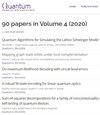cat码的电路级容错
IF 5.1
2区 物理与天体物理
Q1 PHYSICS, MULTIDISCIPLINARY
引用次数: 0
摘要
玻色子编码将量子信息编码成具有纠错能力的单一无限维物理系统。与使用多个物理量子位的标准方法相比,这减少了对许多物理成分的复杂管理的需要。最近关于玻色子编码的讨论集中在纠正玻色子损失误差上,相位误差要么被主动抑制,要么被推迟到标准量子比特编码的后续层。旋转对称玻色子(RSB)码,包括众所周知的cat码和二项码,能够同时校正损耗和相位误差,提供了一种处理基础层任意误差的替代途径。在这里,我们研究这些代码的鲁棒性,从过去更理想的研究转向更接近实际情况的电路级噪声分析,其中设备中的每个物理组件都可能出现故障。我们将容错的概念扩展到RSB码的情况下,然后研究了两种已知的纠错电路在电路级噪声下的性能。我们的分析表明,与过去的工作相比,容错操作的噪声阈值明显更严格;然而,我们展示了如何通过等待时间优化和压缩的使用,我们可以将噪声要求恢复到近期量子硬件可以实现的状态。虽然我们这里的重点是具体的cat代码,但类似的分析适用于一般的RSB代码。本文章由计算机程序翻译,如有差异,请以英文原文为准。
Circuit-level fault tolerance of cat codes
Bosonic codes encode quantum information into a single infinite-dimensional physical system endowed with error correction capabilities. This reduces the need for complex management of many physical constituents compared with standard approaches employing multiple physical qubits. Recent discussions of bosonic codes centre around correcting only boson-loss errors, with phase errors either actively suppressed or deferred to subsequent layers of encoding with standard qubit codes. Rotationally symmetric bosonic (RSB) codes, which include the well-known cat and binomial codes, are capable of simultaneous correction of loss and phase errors, offering an alternate route that deals with arbitrary errors already at the base layer. Here, we investigate the robustness of such codes, moving away from the more idealistic past studies towards a circuit-level noise analysis closer to the practical situation where every physical component in the device is potentially faulty. We extend the concept of fault tolerance to the case of RSB codes, and then examine the performance of two known error correction circuits under circuit-level noise. Our analysis reveals a significantly more stringent noise threshold for fault-tolerant operation than found in past works; nevertheless, we show how, through waiting-time optimization and the use of squeezing, we can restore the noise requirements to a regime achievable with near-term quantum hardware. While our focus here is on cat codes for concreteness, a similar analysis applies for general RSB codes.
求助全文
通过发布文献求助,成功后即可免费获取论文全文。
去求助
来源期刊

Quantum
Physics and Astronomy-Physics and Astronomy (miscellaneous)
CiteScore
9.20
自引率
10.90%
发文量
241
审稿时长
16 weeks
期刊介绍:
Quantum is an open-access peer-reviewed journal for quantum science and related fields. Quantum is non-profit and community-run: an effort by researchers and for researchers to make science more open and publishing more transparent and efficient.
 求助内容:
求助内容: 应助结果提醒方式:
应助结果提醒方式:


